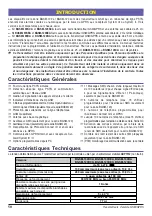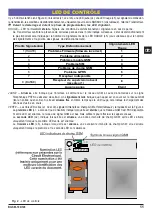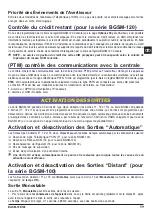
46
GSM/GPRS Alarm Communicators
Service
: A tick
in this column indicates that the Communicator is in its SERVICE status, i.e. when lines 1 and 2
become unbalanced, instead of making a call, the Communicator will take a specific action independently. An action may
be specified for each line, in accordance with the table below. In any case, if these actions are selected, SMS messages
are never sent in reference to inputs 1 and 2.
,
,
,
,
,
CAUTION - These settings also automatically update the parameters on the “SMS dialer”, “Voice dialer”
and “Phonebook” pages.
Control String:
In this column, enter the string (maximum 16 alphanumeric characters) to be sent when you wish to
activate/deactivate the corresponding outlet remotely.
Activation Confirmation:
Use this column to select the type of confirmation you want when the output is activated. There
are 3 different options to choose from: None, Ring or SMS (the latter option is not available if the
Control string
box has
been left empty). The output activation confirmation is forwarded by means of a SMS when the output is activated by SMS.
Monostable:
Normally the outputs, when activated, remain so until a deactivation command is received, at which point
the output will revert to its standby status. If you want the output to revert to its standby status automatically after a set
amount of time, select this option and set the activation time using the adjacent
Monostable Time (sec)
box.
Monostable Time (sec):
In this box, enter the value in seconds (from 1 to 86400 in steps of 1 second) indicating the time
period for which the output, if set as Monostable, will remain active before reverting to its standby status (
ON Time
).
Voice Dialer (BGSM-120 series only)
This section is used to program all parameters relating to the voice dialer, namely: the telephone numbers to call (the first 8
numbers in the phonebook), the number of repetitions for each message (minimum 1, maximum 8), the duration and number
of the messages in accordance with the following specifications:
Description:
This column lists the events for which a voice message may be programmed.
,
,
,
,
,
To select voice messages for the 3 programmable input lines, set the corresponding terminal as an
input (see I/O->Type).
Telephone numbers:
Click the ‘12345678’ columns in accordance with the desired event. The tick
indicates that a
particular telephone number will be called when an event occurs. Click the boxes to enter/remove the tick
.
,
,
,
,
,
The telephone numbers are the first 8 entries on the “Phonebook” page.
Voice Message:
Triple-click the ‘
Message
’ column corresponding to the desired event, then click the button to scroll
through the list of messages (up to 8 messages can be selected, each with a maximum duration of 16 seconds) and
select one. Up to 3 voice messages can be selected for each event (
Message#1
,
Message#2
,
Message#3
).
Repeat Call:
This field is used to enter the number of attempts to be performed (up to a maximum of 8) if the call is not successful.
Repeat Message:
This field is used to enter the number of times a message is repeated (up to a maximum of 8) when
the call is answered.
Input line
no.
Selection
Associated Service function
1
A
Forced switching on GSM network
2
B
Delete telephone queue
Table: Programming Effects on Activation Output
PROGRAMMING
EFFECTS
Black List White List
Activation
Confirmation
Call
Forwarded
Confirmation
Ring
None
YES
NO
Ring
NO
YES
None
YES
NO
Ring
NO
YES
None
NO
NO
Ring
NO
YES
None
YES
NO
Ring
NO
YES
Enabled
Disabled
Содержание BGSM-100 Series
Страница 9: ...I I I I I BGSM 100 120 9 Fig 3 Esempio di collegamento per la serie BGSM 100 e BGSM 120...
Страница 32: ...32 GSM GPRS Alarm Communicators Fig 3 BGSM 100 and BGSM 120 wiring diagram...
Страница 54: ...54 Transmetteurs d alarme GSM GPRS Fig 3 Exemple de branchement pour la s rie BGSM 100 et BGSM 120...
















































